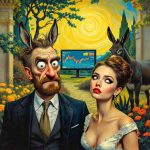
The Gold in the Trash: How Legends Spot What the Herd Misses
May 21, 2025
Every market cycle, every asset bubble, every parabolic rise and catastrophic fall begins with one thing: perception. Not value, not numbers, nor even logic—but the volatile, shifting consensus of what is worthy and what is, as the crowd so often sneers, “trash.” Yet, history repeatedly vindicates the few who see through the noise, those who find gold exactly where others discard it. This is not luck. Its vision is sharpened by experience, humility, and a willingness to step where others won’t.
From Mockery to Mastery: The Power of Unpopular Ideas
The journey begins with rejection. Imagine a student, eager and bright, presenting a forgotten stock to the public. On financial Twitter, it draws nothing but derision: “Boomer stock,” “Dead money,” “Touch grass, bro.” Likes trickle in, but insight is absent. In the meme-stock Discord, the response is harsher—no options flow, no narrative, not even worthy of speculation. The herd dismisses it without thought, their attention span chained to whatever is trending, whatever is loudest.
But the real alchemy happens not in the echo chambers, but in quieter rooms. The student’s final stop is a circle of old contrarians—investors who have endured every market trauma from Volcker’s interest rate shocks to the pandemic’s chaos. They look past the surface. They read the filings, study the chart, and—importantly—listen to the silence. For it is in the absence of noise, in the lack of attention, that true opportunity often hides.
The lesson here is stark: crowds do not allocate capital efficiently. They chase stories, narratives, and momentum, rarely pausing to question their own assumptions. Legends, on the other hand, endure ridicule because they know that the greatest trades are often invisible to the masses—until, suddenly, they’re not.
Why the Herd Misses the Obvious (and the Hidden)
Why is it so easy for the crowd to overlook opportunity? The answer lies in psychology. People crave affirmation, not truth. Consensus feels safe; dissent feels lonely. When the majority brands something as worthless, most simply accept it, eager to avoid the discomfort of being wrong alone. This is not just groupthink—it’s a survival mechanism. But it’s also the root of mediocrity in investing.
Financial markets are not efficient calculators of value. They are complex theatres of human emotion, fear, greed, and impatience. What’s dismissed as “trash” is often just misunderstood—or, more dangerously, ignored because it doesn’t fit the current narrative. The US stock market’s history is littered with companies written off in one decade, only to roar back in the next. Apple in the late 1990s. Amazon after the dot-com crash. Both were left for dead, but patient conviction turned “trash” into trillion-dollar triumphs.
The Contrarian’s Toolkit: Pattern Recognition Beyond the Noise
Legends aren’t immune to mistakes. But they wield a toolkit that the herd rarely bothers to assemble. They look for patterns—both in price and in behaviour. They notice when selling pressure dries up, when insiders quietly accumulate, when fundamentals improve while headlines remain hostile. They understand that stories change faster than underlying business realities.
This is not about mindless contrarianism—buying “bad” assets simply because they’re unpopular. It’s about selective attention: having the discipline to ignore the crowd’s latest obsession, and the curiosity to investigate what everyone else has abandoned. It means reading financial statements, assessing management changes, and—critically—asking: “If this truly is trash, why are the smartest, quietest players buying?”
The process is rarely glamorous. It requires patience, humility, and the ability to endure ridicule. But it also demands urgency: when legends spot value, they move before the crowd wakes up. As the old contrarian in the story said, “When it moves—hell’s gonna break loose.” Timing is everything. Too early, you endure more pain; too late, and you’re just another face in the stampede.
Patience, Timing, and the Art of Enduring Silence
The hardest part of this approach is not the research or risk—it’s waiting. Markets can remain irrational longer than most can remain solvent or patient. The value investor lives in a permanent state of anticipation, quietly accumulating while others scoff. But when the turn comes—when yesterday’s trash becomes today’s treasure—the rewards are disproportionate.
This is the inflexion point, the moment when value and narrative converge. Suddenly, analysts rediscover the stock, headlines turn positive, and the crowd—once dismissive—piles in with fervour. But by then, the legends are already in position. They bought when it was hard; they sell when it’s easy.
Consider the aftermath: the same voices that mocked and ignored now rage and FOMO-buy, often at the top, driven not by insight but by regret and envy. This is the cruel irony of markets—the greatest gains accrue to those who acted with conviction when it felt loneliest.
Finding Signal: The Quiet Discipline of Value
What separates signal from noise? Legends cultivate a sixth sense for value—an ability to see through narrative fog and spot genuine opportunity. Sometimes, this is quantitative: low price-to-earnings ratios, healthy balance sheets, insider buying. Other times, it’s qualitative: a new product, a shift in industry dynamics, a change in leadership. But always, it is measured against the indifference or scorn of the crowd.
To find gold in the trash requires more than just analysis. It demands an almost philosophical view of markets—a recognition that perception and reality can diverge wildly, and that the journey from scorned to adored is where the greatest alpha lies. It is about understanding that markets don’t price assets; people do. And people are, more often than not, wrong together.
Legends feast at the inflexion point precisely because they do not beg for applause or validation. They know that the crowd’s opinion is the last thing to change. As the mentor in the story said, “find signal, understand value before the herd does—and you’ll feast while the rest starve on regret.”
Lessons from the Legends: Actionable Insights
What can the everyday investor learn from these legends? First, cultivate independent thinking. Don’t take consensus at face value—ask why the crowd believes what it does, and what it might be missing. Second, embrace discomfort. The best trades often feel wrong initially because they defy the prevailing wisdom. Third, do the work. Legends don’t just buy unloved stocks blindly; they research, wait, and position themselves quietly.
Fourth, be patient. The market rewards those who can wait for value to be recognised, not those who chase every trend. Fifth, prepare for ridicule. If your thesis is truly unique, it will sound absurd to most. That’s a feature, not a bug. Finally, act decisively when the moment comes. Opportunity is perishable; hesitation is costly.
The Climactic Quiet: When Gold Emerges from Trash
In the end, the greatest opportunities are rarely found in the crowd’s noise. They emerge in silence, in places scorned and ignored, in assets dismissed as trash. The legends know this. They watch, they wait, and when the signal appears—when they see gold where others see only rubbish—they move, not for applause, not for validation, but for the quiet satisfaction of seeing what others missed.
For most, the journey ends in regret—buying high, selling low, following the crowd into oblivion. But for those willing to dig through the trash, to listen to the silence and trust their own judgement, the rewards are more than financial. They are intellectual, even spiritual—a testament to the power of independent thought in a world addicted to consensus.










